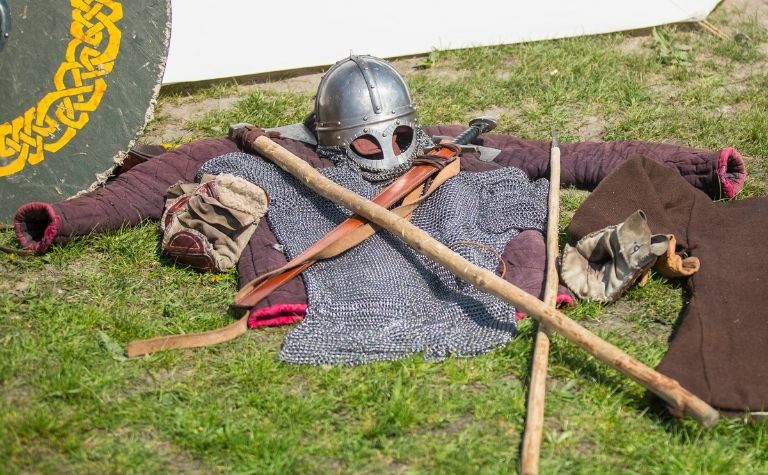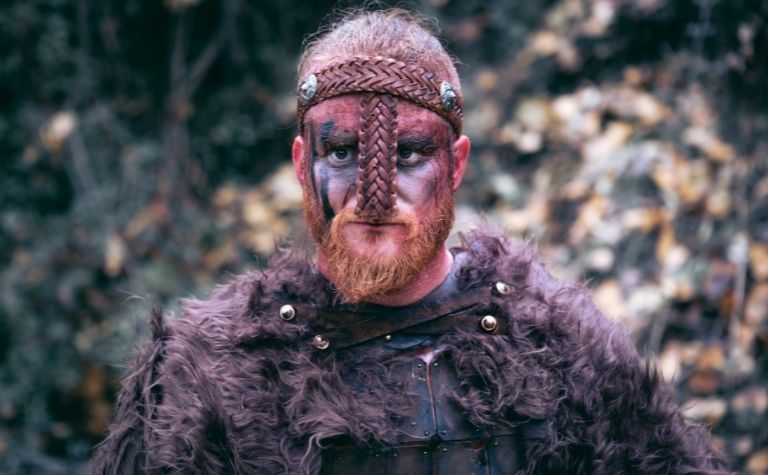Posterity admires the fierce Viking warriors for crafting simple but deadly weapons.
Those fascinated by Viking exploits and stories often wonder how the fighters protected themselves during the fierce battles.
Unfortunately, there’s not as much information available on Viking armor as there’s about their weapons.
Leather armor was prevalent during the Viking era. Historians widely hold that the Vikings wore leather armor made from reindeer hide.
Many fighters couldn’t afford chainmail shirts because iron was expensive and cumbersome to extract. They also made other items of clothing from leather.
Read on to learn how the Vikings protected themselves during combat and what made up their defense arsenal.
The article also attempts to answer popular questions like whether Viking fighters wore animal skins during battle and if the chainmail shirt was part of a standard armor kit.
Also see What Country Has the Most Viking Heritage? to learn more.

What Did Vikings Use To Absorb Hits When Fighting?
The Vikings used shields, helmets, and chainmail armor to absorb hits when fighting. Because iron was difficult to excavate, armor pieces were costly to produce.
So, only the wealthiest Viking warrior could use the whole set of armor. Poorer Vikings used only shields to protect themselves.
How rich a Viking warrior was could be determined by his defense arsenal. Not all Viking warriors had the financial means to use armor.
Many poor Vikings fought with only an ax and didn’t carry shields or wear helmets or chainmail armor.
Here’s what the typical Viking armor set consisted of:
Shield
All Viking men usually carried a round shield. These shields were up to a meter in width and made of wooden boards riveted together.
A hole in the center allowed the carrier to grip the shield. Sometimes the shields were covered by leather. These were often decorated or painted with images depicting mythological heroes.
A big, round shield offered considerable protection from incoming blows.
When fighting in a shield wall, Viking fighters usually didn’t need the protection of chainmail shirts.
The shield was a standard component of the Viking defensive kit.
All crew members of ships had to carry shields.
Also see Vikings vs Spartans: What’s the Difference? to learn more.
Helmet
Viking helmets were simple pieces consisting of a conical iron cap with a nose piece and eye guards.
Some helmets were fitted with mail sheets at the back to protect the wearer’s neck.
Iron was expensive to procure, so many Viking warriors wore leather helmets similarly built.
Contrary to images depicted in popular culture, Viking helmets used on the battlefield didn’t have horns. Horned helmets would have been impractical in a battleground setting.
Chainmail
Some Viking warriors wore chainmail shirts made of iron rings closely linked to one another.
But these were expensive to produce, and only the richest men could buy them.
Historians believe some warriors may have used leather shirts to protect themselves from hits.
Contrary to what pop culture images portray, Viking fighters didn’t wear bulky, full-body steel suits that knights wore. [1]
Also see Is the Minnesota Vikings Helmet Supposed To Be Thor? to learn more.

Did the Vikings Use Animal Skins for Armor?
Some poor Vikings used animal skins for armor. Sometimes they also covered their shields with leather.
While some Viking warriors wore leather clothing and leather helmets during combat, not all warriors could afford to use chainmail shirts and iron helmets because iron was expensive to extract.
Historians today piece together facets of Viking life from relics and artifacts found in tombs.
There aren’t many preserved specimens of animal skin clothing, but leather tends to rot away without a trace.
Sometimes, it’s also challenging to reconstruct wearables and accurately determine the nature of clothing.
There are several arguments in favor of the theory that Vikings used animal skins for armor:
Narrative Accounts Claim Vikings Used Leather
Several Norse narrative accounts mention that the Viking warriors used leather armor.
For instance, the following description of a battle scene is found in Heimskringla, Volume II: The Saga of Olaf Haraldson:
“King Óláfr struck at Þórir hundr across the shoulders. The sword did not cut, and it looked as though dust flew up from the reindeer skin.” [2]
Vikings Used Leather for Other Items of Clothing
The Vikings used animal hide to make several pieces of clothing, such as belts, shoes, and hats. They also made bags, backpacks, and saddles from leather.
So, it would not be wrong to assume that they used animal skins to craft armor.
Animal Skin Was Widely Available
The Vikings raised cattle. They also raided other regions for cattle. Besides, they were a meat-consuming race.
They hunted reindeer, and their diet included beef, mutton, and horse meat. They had animal hide at their disposal; it would be feasible to use the skins to make armor.
Also see What Did the Vikings Look Like? to learn more.
Leather Armor Has Several Unique Advantages
Leather isn’t as tough and resistant to hits from weapons as chainmail. But using animal skins for armor provides certain other unique advantages:
- They’re thick and protect the wearer from knife slashes and moderate blows.
- They don’t restrict movement during combat or swimming.
- They’re lightweight.
- They’re cheap and easy to manufacture.
- They protect the warriors from the cold.
The Vikings were aware of the unique benefits of using animal hide to make items of clothing.
It would be logical to assume that they used leather to derive an added layer of protection during combat.
Europeans Processed Leather Throughout History
Several European races, contemporaries of the Vikings, used a hide processing technique to produce a type of hardened leather called cuir bouilli.
It was made by boiling animal skin and applying wax to it.
The end product was sturdy but malleable, with impressive abilities to absorb the shock of hits and blows and withstand cuts and slashes from sharp weapons.
The Vikings were probably familiar with the technique of producing cuir bouilli, which also sounds easy to carry out.
What bolsters this presumption is the fact that a cuir bouilli leather shield dating back to the Bronze Age, an era close to the Viking period, was found in Ireland.
The Vikings Traveled to Regions Where Leather Was Used
The races of people who lived around Viking territories used leather armor. The Vikings traveled to distant lands to raid and explore greener pastures.
They were probably influenced by the practices prevalent in the other cultures with which they came in contact.
Also see Were the Vikings Literate? to learn more.

Did the Vikings Wear Chainmail in Combat?
Only wealthy Viking warriors wore chainmail shirts during combat. Iron was an expensive metal, and poor Viking fighters couldn’t afford to buy chainmail armor made by interlinking iron rings.
Those who couldn’t afford chainmail armor sometimes wore thick wool clothing or leather garments.
Thick wool clothing can cushion the blow from a weapon and protect the wearer from knife slashes. It also protected wearers from the cold when they were at sea.
Conclusion
Not all Viking warriors used armor during combat. This warrior race triumphed primarily because of their fighting skills.
Also see Why Didn’t the Vikings Colonize America? to learn more.
